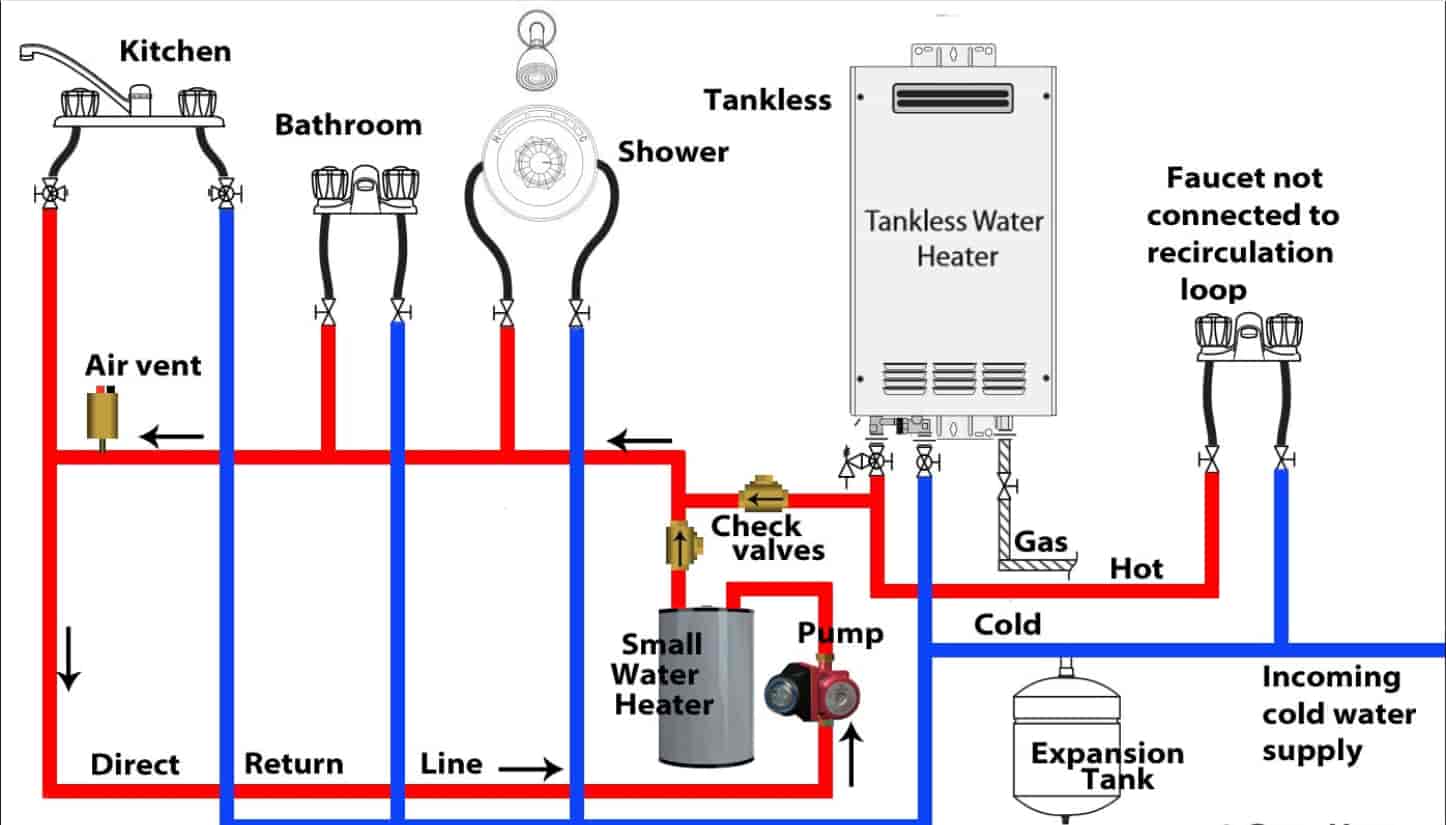It is more than often that some or other clients of mine would come to me and ask, do I need a recirculation pump for a tankless water heater?
So, I decided to end this age-old debate by answering the question in the best possible manner that I could.
Frankly speaking, it isn’t compulsory to have a recirculating pump along with a tankless water heater. However, having one will definitely reduce the wait time for the hot water as well as will save you a tangible amount of hot water over the years.
If you’re one of my clients and reading this post then you’ll find the same thing that I’ve said to you verbally.
So, without any further ado, let’s begin…
Is Recirculating Pump Worth The Money?
Well, to begin with, the beauty of any tankless water heater, be it an electric one or a gas variant is, it can provide you with an endless supply of hot water effortlessly.
Furthermore, a tankless water heater doesn’t store hot water in a tank rather it provides hot water instantly and “on-demand” without any hassle.
So, there isn’t any “standby” heat loss to the environment which slowly and gradually will add to electricity bill saving in the long-run.
Unfortunately, like any other product, a tankless hot water heater has its own share of cons as well.
As compared to a conventional tankless water heater, a tankless heater requires some wait time before you get the hot water coming out of a faucet, shower, etc.
And, the worst part is, while you’re waiting for the hot water to come out of the faucet, a tangible amount of water gets wasted.
The cold water present in the pipe needs to be moved out so that the hot water can reach out to you.
For instance, the amount of cold water getting wasted might seems very little for you but if you’ll calculate it for an entire year, then it might reach up to 10, 000 gallons of water.
In order to save the cold water while waiting for the hot water to come out of the fixture, some of my clients said that they catch them in the bucket.
COOL…
You can do that as well, and if that doesn’t interest you, then I’ve got a better option for you.
Yes, you guessed it, RIGHT!
It’s none other than the recirculating pump, and trust me, it will do wonder for you if things are done rightly.
A recirculating pump helps a tankless water heater in keeping hot water in the tap and making it instantly available at the sink as well as a shower.
Moving further, I would be vomiting anything and everything that I know about the recirculating pump.
What is a recirculation pump for a tankless water heater?
A recirculation pump aka circulator pump periodically circulates water back to the water heater to be reheated.
What actually it does is, prevents water in the pipe from cooling off, and as a result, you’ll find hot water in the tap whenever you turn it ON.
In simple words, a recirculating pump system is set up to circulate the water between the heater and the furthest fixture from it.

So, what does a recirculating pump system includes?
Water Heater And Pump
One of the main components of the recirculating pump systems is the water heater and pump in the combined or separate form.
What I actually mean is, it can be a tankless water heater with an integrated recirculation pump or a water heater and an external pump.
Most of the premium tankless water heater brands including Rheem has some really good tankless models with built-in recirculation pump.
On the other hand, we have got a brand like Rinnai that has launched tankless models which can be programmed to start an external pump during peak water usage times.
Recirculation Method
When it comes to the selection of a recirculation method, you’ve got two options.
Let’s discuss each option in-detail.
The first option gives you the option of a dedicated return line for circulation.
Well, many of you would be wondering, what it actually means, right?
In layman’s language, your home will have three pipes instead of two, that is, cold, hot, and recirculation.
Frankly speaking, this is definitely a viable option when the plumbing is originally installed or if you’ve got a one-story home and pipes in the basement.
What if, your home doesn’t have a recirculation pipe?
In that case, a bridge valve will be installed at the furthest fixture allowing the cold water line to be used as the means of cycling water back to the water heater.
A way to control when the circulation pump runs
It is equally important that whenever a circulation pump runs it runs under control.
The first option that we’ve is a timer that periodically runs on the recirculation.
And, the second option that we’ve got is a thermostat that turns on the pump in order to keep the water in the line at the desired temperature.
Many of the good-quality recirculation pumps come with a built-in thermostat or a timer.
I’m attaching a self-explanatory video about How Rinnai’s ThermaCirc360™ Recirculation Works?
Pros and Cons of Recirculation
Let’s have a quick look at the pros and cons of recirculation which will help you in making an informed buying decision.
Pros
As per my knowledge and experience, I can affirm that a whole house tankless water heater that comes with a built-in recirculating system is definitely user-friendly and more convenient to use.
A recirculation pump drastically reduces the wait time from a couple of minutes to few seconds or even less.
Not only does it reduces the wastage of cold water but also enhances the end user’s experience, isn’t it?
Another benefit of using a recirculation pump is that you’ll save water which is a natural resource and can be a great asset for the future generation.
Furthermore, recirculation technology doesn’t consume much energy.
In fact, the recirculation system only consumes electricity for the time it takes the hot water to reach the water tap.
Cons
Needless to say, a recirculation pump does has its own share of cons which you should know before you make a buying decision.
A recirculation pump comes with an additional installation cost which will fall in the range of $300 and $1800, and sometimes cost can further exceed as well, depending upon the type of equipment that you’re planning to buy as well as who is carrying out the installation process, that is, you or a certified professional.
Secondly, a recirculation pump does possesses some operating cost.
So, do you need a recirculation pump with your tankless water heater?
I hope and believe that most of you would’ve definitely found the reason why or why not, you should opt for a tankless water heater with a built-in recirculation pump.
In case, your primary concern is the additional cost that comes as baggage with the tankless unit.
Then, please allow me to throw more light on it so that you can get a picture of a recirculation pump equipped tankless water heater.
Cost
To be honest, knowing the cost is very important especially if you’re on a shoestring budget so that you can opt for a “value for money” recirculation system.
Before I walk you through the costing, I just want to affirm that it is just a rough estimate and can vary significantly in some exceptional cases.
Tankless Water Heater With Recirculation Pumps
If you’re planning to buy a tankless water heater that comes with a built-in recirculation pump, then you need to keep in mind that it might cost you up to 500 dollars more as compared to those without pumps.
I would suggest you should prefer this option if you’re installing a new water heater as it will save you the cost of pump installation.
Separate Recirculation Pumps
If you’ve got a tankless water heater installed that doesn’t come with a built-in recirculation pump, then in such a scenario, a separate recirculation pump can do the trick for you.
The cost of a separate recirculation pump would fall in the range of $200 and $500, depending on the size required.
However, if you’re NOT willing to incur additional installation costs, then you can opt for the tankless model that comes with a DIY installation.
In case, you’re planning to hire a certified plumber, then it might cost you an additional 200 to 300 dollars.
Complete Kits
Well, if you’re not installing a separate recirculation pipe, then, in that case, you can install a bridge valve.
They are cheaper and you can find one at as low as 25 dollars.
Moreover, they are also available in complete kits along with the pump and thermostat.
Most of the kits you’ll find in the range of $300 and $500.
Recirculation Line
If you’re installing the line along with other plumbing installations, then, in that case, the expenditure would be roughly in the range of $100 to $250 based on the length of the line.
However, if you’re installing the line later then it could cost you as high as $1000.
Coming back to whether you need a recirculation pump with your tankless water heater totally depends on your requirements.
If convenience and long-term benefits such as water-saving are your top priority, then definitely, you should invest in a tankless water heater with a built-in recirculation pump.
Otherwise, you can also get the recirculation pump installed if your tankless heater doesn’t possess it.
Wrapping Up
First and foremost, I would like to thank you for being with me till the end.
Secondly, I would like to bring to your notice that I along with my team have put loads and loads of effort into coming up with the best answer that we could.
And, in case, you’ve liked our efforts, then share this piece of information with the ones who are in need of it.
After all, sharing is caring, isn’t it?
[Also Read]
- Will Vinegar damage a hot water heater?
- All You Need To Know About Tankless Hot Water Heaters?
- Can you run out of hot water with a tankless water heater?
- What size tankless water heater do I need?
- Is a tankless water heater worth it?
- Will a single tankless unit be enough for my house?
- Tankless water heater pros and cons
- How many amps does a tankless water heater draw?
- How long does it take to make a tankless water heater pay back for itself?
- Why does it take so long to get hot water from my tankless water heater?

